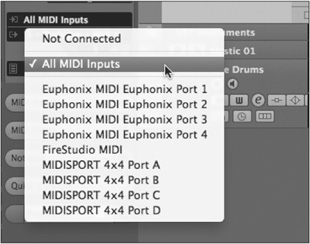Recording Multi-Channel MIDI Data
One MIDI track can contain all sorts of data from multiple sources and multiple MIDI channels. Since each MIDI port is capable of receiving data across all 16 MIDI channels and each MIDI track can record data from multiple MIDI inputs, it is quite possible to record MIDI data from several musicians all together on one track.
All MIDI Inputs
In the top Inspector tab for any MIDI track, you will find the input selection menu. Choosing All MIDI Inputs allows you to record from multiple MIDI ports at the same time and mix the data onto one MIDI track. (See Figure 8.26.)
Figure 8.26 Selecting All MIDI Inputs as the input for a MIDI track.

The MIDI Port Setup gives you the choice of which MIDI ports will be included from your system in the All MIDI Inputs selection. MIDI ports that contain control data for the mixer and external control surfaces should not be included for recording musical data under normal circumstances. Select any port that has a MIDI controller connected to it that you will use to generate musical data and check its column to add it to In All MIDI Inputs.
As an example, let’s say you are tracking a live band and the piano player is using a keyboard to generate the piano sound. You can record the MIDI output of that keyboard along with the audio output during the recording session. The MIDI data can then be used later to generate alternate piano sounds from VSTis or even other keyboard sounds such as synth pads or even a Wurlitzer piano sound. In addition, the drummer has installed triggers on the drums and has a triggering module set up to generate the resulting MIDI data. You may record this MIDI data as well for use later in replacing drum sounds or augmenting the recorded drums sounds during the mix.
Both of these MIDI data streams can be recorded to one track for the sake of expediency during the tracking session and then later extracted to their own MIDI tracks for use in the mix. Create a MIDI track and set its input to All MIDI Inputs so that data from both devices is recorded together on the track.
Extracting Multi-Channel Data—Logical Editor
The wonderful thing about MIDI data is the ability to endlessly manipulate it after it has been recorded. In the case of multi-channel data recorded onto one MIDI track, it is possible to extract the data from each channel and place it on its own MIDI track to allow for further editing and manipulation.
To do this, we will use the logical editor, which can manipulate MIDI data in a staggering number of ways, and this example is just an introduction to its possible uses. This editor uses functions to extract data and then perform various actions on that data. In this case, we need to extract data from one MIDI channel and paste it into a new MIDI track.
Here’s how it works:
1. Record some multi-channel data onto one MIDI track. (See Figure 8.27.)
Figure 8.27 The upper MIDI events are a keyboard part while the lower ones are drums.

2. Open the list editor to identify what MIDI channels are being used. (See Figure 8.28.)
3. From the MIDI menu, open the logical editor. The logical editor has top and bottom panes. The top pane identifies data through use of filters—in this case, a filter by MIDI channel. You can set up multiple filters by clicking +. This filter is set up to find data that uses MIDI channel 10 for the drums. (See Figure 8.29.)
Figure 8.28 The list editor showing data on channels 1 and 10.
Figure 8.29 Logical editor set up to find data on MIDI channel 10 and extract it.

4. The lower pane provides an action list that can process this data. In this case, there is no need to actually process the data because we only want to move it to a new MIDI track.
5. At the bottom of the window is the Function menu. The possibilities are Delete, Transform, Insert, Insert Exclusive, Copy, Extract, and Select. In this example, extraction is the goal.
6. Click the Apply button to execute the filters, actions, and functions all at once.
The result is that the filtered data is removed from the first MIDI track and placed on a newly created MIDI track directly beneath the original. Now we have two MIDI tracks: one with piano only and the other with drums only. (See Figure 8.30.)
Figure 8.30 The resulting two MIDI tracks.

This is just a simple example of the logical editor’s possibilities. MIDI data provides a unique way of processing musical information that straight audio recording cannot. Experiment and explore its possibilities.
This is just the beginning of all the editing possibilities in Nuendo. The next section of the book, Part III, “Editing,” is all about them.

